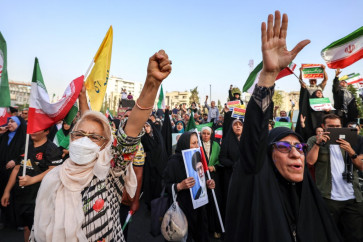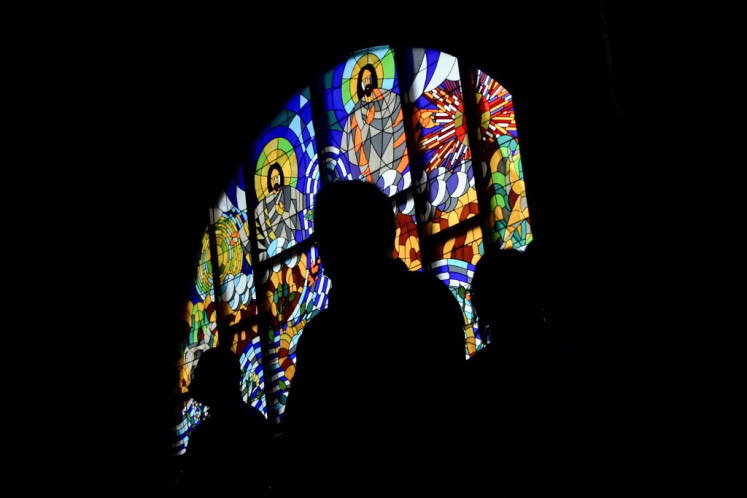Popular Reads
Top Results
Can't find what you're looking for?
View all search resultsPopular Reads
Top Results
Can't find what you're looking for?
View all search resultsIn search of an inexpensive 'ngaben'
Simple: Relatives pray before the start of a simple cremation ritual at Santha Yana crematorium
Change text size
Gift Premium Articles
to Anyone
![Simple: Relatives pray before the start of a simple cremation ritual at Santha Yana crematorium. The picture is of the first cremation which took place in the facility in late 2008. (Courtesy Santha Yana crematorium)" border="0" height="383" width="510"><span class="caption" style="width: 508px;"><strong>Simple: </strong>Relatives pray before the start of a simple cremation ritual at Santha Yana crematorium. The picture is of the first cremation which took place in the facility in late 2008. (Courtesy Santha Yana crematorium)</span></span></p><p>Sari succumbed to her illness on a cold Friday morning. Her granddaughter was rubbing Sariâs feet with oil when she died.<br><br>Illness had confined Sari (not her real name) to bed for months and her passing had brought to her family a sense of grief and relief at the same time.<br><br>Soon, the familyâs compound, which lies in one of the most densely populated areas of East Denpasar, was filled with relatives and members of the local banjar, or traditional neighborhood association.<br><br>Banjar and desa pekraman (traditional customary villages) organize all major rite-of-passage rituals for their members, including burial, cremation and post-cremation ceremonies. <br><br>Costs, however, remain the responsibility of the families.<br><br>The money needed for the cremation (ngaben) was on the minds of Sariâs children and familyâs elders that night. The family spent more than Rp 50 million (US$4,341) on a ngaben for Sariâs husband just three months ago.<br><br>âThe banten [offering] for the ngaben will cost us Rp 15 million,â a family member whispered. âThatâs just for the offering.â</p><p><span class="inline inline-none"><img class="image image-img_assist_custom-510x340 " src="http://202.158.21.182/files/images2/p21-bpartinggift.img_assist_custom-510x340.jpg" alt="Parting gift: Relatives place money and valuable items on the coffins before the body is cremated. (JP/Agung Parameswara)" title="Parting gift: Relatives place money and valuable items on the coffins before the body is cremated. (JP/Agung Parameswara)" border="0" height="339" width="510"><span class="caption" style="width: 508px;"><strong>Parting gift: </strong>Relatives place money and valuable items on the coffins before the body is cremated. (JP/Agung Parameswara)</span></span><br>The modest family is not wealthy, but had no choice but to pay for another costly ritual. Tradition dictates that the deceased must be cremated, not buried. Here, tradition is everything.<br><br>As women from the banjar came to the house to offer condolences and traditional gifts of rice, sugar, coffee and white cloth, the family meeting reached a critical point.<br><br>Sariâs daughter suggested that the family could hold a ngaben at a Hindu crematorium in a neighboring village instead of the local cemetery.<br><br>Modeled after a Chinese crematorium in Mumbul, Nusa Dua, the Hindu crematorium has offered inexpensive and time-efficient ngaben since 2008. <br><br>It had enjoyed a growing acceptance among Balinese Hindus, especially those with small families or living in the city.<br><br>The suggestion, however, was shot down by the elders, citing loyalty to the banjar, family pride and local tradition. All the family could think about was how to get the Rp 50 million.</p><p>The story of Sariâs family is not unusual.<br><br>âIt is very common here to pay little attention to the needs of the elderly members of the family when they are still alive and then spend a huge sum of money to finance their cremation,â Anak Agung Sagung Mas Ruscitadewi, a poet and member of Kesiman royal family, said.</p><p><span class="inline inline-none"><img class="image image-_original " src="http://202.158.21.182/files/images2/p21-apreparation.jpg" alt="Preparation: Several men craft bull sarcophagi to be used in a mass cremation. (JP/I Wayan Juniarta)" title="Preparation: Several men craft bull sarcophagi to be used in a mass cremation. (JP/I Wayan Juniarta)" border="0" height="341" width="512"><span class="caption" style="width: 510px;"><strong>Preparation: </strong>Several men craft bull sarcophagi to be used in a mass cremation. (JP/I Wayan Juniarta)</span></span><br>âMajor ceremonies, including ngaben, are seen as a chance to display the familyâs social status and wealth as well as the familyâs affection for the deceased.â<br><br>She admitted that royal families were setting an example.<br><br>For instance, the royal version of the ngaben â the pelebon â organized by Ubudâs royal family involve 20-meter-tall cremation towers, gigantic lembu sarcophagi, a cast of thousandsâ including a line-up of highly-respected Hindu high-priests â and a Rp 1 billion price tag.<br><br>These sorts of majestic public spectacles have been good for tourism, while encouraging emulation from non-royals.<br><br>âFamilies have to borrow money from banks or sell family rice fields to fund the cremation, thus, significantly reducing the familyâs ability to save and invest,â Hindu scholar Ketut Sumarta once said. âThis trend of organizing lavish ceremonies will, in the long term, cause bankruptcy for middle and low-income Balinese families.â <br><br>More recently, Hindu scholars, influential figures and high priests have campaigned for more substantive rituals. <br><br>âThe essence of the ngaben is the duty, devotion and love of the family to the deceased,â Hindu cleric Ida Bhawati Hermawan Tangkas said during a mass cremation in late August in Singaraja. âIt is also an act of expediting the return of the deceased into the five principal elements. Mass cremation is a strategic initiative for families who donât have sufficient funds to do a ngaben by themselves, as well as a display of the spirit of togetherness and simplicity.â <br><br>Six-hundred-and-forty-three families recently participated in a ritual organized by the Singaraja chapter of the Bugbug Peopleâs Association (IWB) for transmigrants. It took two years to organize. IWB chapter head I Gde Wisnaya Wisna said that plan was conceived after the association learned of the financial situation of its members.</p><p><span class="inline inline-none"><img class="image image-img_assist_custom-510x340 " src="http://202.158.21.182/files/images2/p21-eofferings.img_assist_custom-510x340.jpg" alt="Offerings: Women carry offerings in a procession to the site of a mass cremation. (JP/Agung Parameswara)" title="Offerings: Women carry offerings in a procession to the site of a mass cremation. (JP/Agung Parameswara)" border="0" height="339" width="510"><span class="caption" style="width: 508px;"><strong>Offerings: </strong>Women carry offerings in a procession to the site of a mass cremation. (JP/Agung Parameswara)</span></span><br>âMost of them only had enough money to finance their householdsâ daily necessities and could not afford to finance a cremation, despite the fact that cremation is an obligation and a debt that we must pay to our ancestors,â Wisna said.<br><br>Mass cremations, where several families pool their resources, have grown increasingly popular as an inexpensive alternative that cost as little as Rp 5 million and still offer a sense of community.<br><br>Another popular alternative has been offered by the Santha Yana Hindu crematorium in Peguyangan Kangin, Denpasar, established by the islandâs largest clan-based organization, Mahagotra Pasek Sanak Sapta Rsi (MGPSSR), locally known as the Pasek clan, comprising the descendants of seven sages from ancient Bali.<br><br>The MGPSSR is a progressive organization that for decades has fought against various outdated traditions of Hinduism, including the remnants of feudalism, rigid interpretations of caste as well as the hegemonic influence of high priests from the Brahmin family. <br><br>It was responsible for organizing the first mass cremation in the 1960s.<br><br>The idea for the crematorium was brought up during the clanâs pesamuhan agung (annual congress) in 2009. Clan leaders and scholars were concerned with an increasing number of conflicts resulting in a ban on some families from using local cemeteries for ceremonies.<br><br>âThere are also problems for low-income Balinese households who cannot to afford the expensive ngaben and thousands of Balinese working outside Bali who do not belong to any specific customary hamlet or village, who have no right to use the local cemetery,â MGPSSR chairman I Wayan Wita said.<br><br>The organization spent Rp 300 million to construct a simple crematorium and allocated Rp 500 million to modernize it.</p><p><span class="inline inline-none"><img class="image image-img_assist_custom-510x340 " src="http://202.158.21.182/files/images2/p21-cheavenlymount.img_assist_custom-510x340.jpg" alt="Heavenly mount: Fire consumes the bodies placed inside wooden sarcophagi in the shape of bull, the vehicle of Lord Siwa the Destroyer. (JP/Agung Parameswara)" title="Heavenly mount: Fire consumes the bodies placed inside wooden sarcophagi in the shape of bull, the vehicle of Lord Siwa the Destroyer. (JP/Agung Parameswara)](https://www.thejakartapost.com/files/images2/p21-dsimple.img_assist_custom-510x384.jpg) Simple: Relatives pray before the start of a simple cremation ritual at Santha Yana crematorium. The picture is of the first cremation which took place in the facility in late 2008. (Courtesy Santha Yana crematorium)" border="0" height="383" width="510">Simple: Relatives pray before the start of a simple cremation ritual at Santha Yana crematorium. The picture is of the first cremation which took place in the facility in late 2008. (Courtesy Santha Yana crematorium)
Simple: Relatives pray before the start of a simple cremation ritual at Santha Yana crematorium. The picture is of the first cremation which took place in the facility in late 2008. (Courtesy Santha Yana crematorium)" border="0" height="383" width="510">Simple: Relatives pray before the start of a simple cremation ritual at Santha Yana crematorium. The picture is of the first cremation which took place in the facility in late 2008. (Courtesy Santha Yana crematorium)Sari succumbed to her illness on a cold Friday morning. Her granddaughter was rubbing Sariâs feet with oil when she died.
Illness had confined Sari (not her real name) to bed for months and her passing had brought to her family a sense of grief and relief at the same time.
Soon, the familyâs compound, which lies in one of the most densely populated areas of East Denpasar, was filled with relatives and members of the local banjar, or traditional neighborhood association.
Banjar and desa pekraman (traditional customary villages) organize all major rite-of-passage rituals for their members, including burial, cremation and post-cremation ceremonies.
Costs, however, remain the responsibility of the families.
The money needed for the cremation (ngaben) was on the minds of Sariâs children and familyâs elders that night. The family spent more than Rp 50 million (US$4,341) on a ngaben for Sariâs husband just three months ago.
âThe banten [offering] for the ngaben will cost us Rp 15 million,â a family member whispered. âThatâs just for the offering.â
 Parting gift: Relatives place money and valuable items on the coffins before the body is cremated. (JP/Agung Parameswara)
Parting gift: Relatives place money and valuable items on the coffins before the body is cremated. (JP/Agung Parameswara)
The modest family is not wealthy, but had no choice but to pay for another costly ritual. Tradition dictates that the deceased must be cremated, not buried. Here, tradition is everything.
As women from the banjar came to the house to offer condolences and traditional gifts of rice, sugar, coffee and white cloth, the family meeting reached a critical point.
Sariâs daughter suggested that the family could hold a ngaben at a Hindu crematorium in a neighboring village instead of the local cemetery.
Modeled after a Chinese crematorium in Mumbul, Nusa Dua, the Hindu crematorium has offered inexpensive and time-efficient ngaben since 2008.
It had enjoyed a growing acceptance among Balinese Hindus, especially those with small families or living in the city.
The suggestion, however, was shot down by the elders, citing loyalty to the banjar, family pride and local tradition. All the family could think about was how to get the Rp 50 million.
The story of Sariâs family is not unusual.
âIt is very common here to pay little attention to the needs of the elderly members of the family when they are still alive and then spend a huge sum of money to finance their cremation,â Anak Agung Sagung Mas Ruscitadewi, a poet and member of Kesiman royal family, said.
 Preparation: Several men craft bull sarcophagi to be used in a mass cremation. (JP/I Wayan Juniarta)
Preparation: Several men craft bull sarcophagi to be used in a mass cremation. (JP/I Wayan Juniarta)
âMajor ceremonies, including ngaben, are seen as a chance to display the familyâs social status and wealth as well as the familyâs affection for the deceased.â
She admitted that royal families were setting an example.
For instance, the royal version of the ngaben â the pelebon â organized by Ubudâs royal family involve 20-meter-tall cremation towers, gigantic lembu sarcophagi, a cast of thousandsâ including a line-up of highly-respected Hindu high-priests â and a Rp 1 billion price tag.
These sorts of majestic public spectacles have been good for tourism, while encouraging emulation from non-royals.
âFamilies have to borrow money from banks or sell family rice fields to fund the cremation, thus, significantly reducing the familyâs ability to save and invest,â Hindu scholar Ketut Sumarta once said. âThis trend of organizing lavish ceremonies will, in the long term, cause bankruptcy for middle and low-income Balinese families.â
More recently, Hindu scholars, influential figures and high priests have campaigned for more substantive rituals.
âThe essence of the ngaben is the duty, devotion and love of the family to the deceased,â Hindu cleric Ida Bhawati Hermawan Tangkas said during a mass cremation in late August in Singaraja. âIt is also an act of expediting the return of the deceased into the five principal elements. Mass cremation is a strategic initiative for families who donât have sufficient funds to do a ngaben by themselves, as well as a display of the spirit of togetherness and simplicity.â
Six-hundred-and-forty-three families recently participated in a ritual organized by the Singaraja chapter of the Bugbug Peopleâs Association (IWB) for transmigrants. It took two years to organize. IWB chapter head I Gde Wisnaya Wisna said that plan was conceived after the association learned of the financial situation of its members.
 Offerings: Women carry offerings in a procession to the site of a mass cremation. (JP/Agung Parameswara)
Offerings: Women carry offerings in a procession to the site of a mass cremation. (JP/Agung Parameswara)
âMost of them only had enough money to finance their householdsâ daily necessities and could not afford to finance a cremation, despite the fact that cremation is an obligation and a debt that we must pay to our ancestors,â Wisna said.
Mass cremations, where several families pool their resources, have grown increasingly popular as an inexpensive alternative that cost as little as Rp 5 million and still offer a sense of community.
Another popular alternative has been offered by the Santha Yana Hindu crematorium in Peguyangan Kangin, Denpasar, established by the islandâs largest clan-based organization, Mahagotra Pasek Sanak Sapta Rsi (MGPSSR), locally known as the Pasek clan, comprising the descendants of seven sages from ancient Bali.
The MGPSSR is a progressive organization that for decades has fought against various outdated traditions of Hinduism, including the remnants of feudalism, rigid interpretations of caste as well as the hegemonic influence of high priests from the Brahmin family.
It was responsible for organizing the first mass cremation in the 1960s.
The idea for the crematorium was brought up during the clanâs pesamuhan agung (annual congress) in 2009. Clan leaders and scholars were concerned with an increasing number of conflicts resulting in a ban on some families from using local cemeteries for ceremonies.
âThere are also problems for low-income Balinese households who cannot to afford the expensive ngaben and thousands of Balinese working outside Bali who do not belong to any specific customary hamlet or village, who have no right to use the local cemetery,â MGPSSR chairman I Wayan Wita said.
The organization spent Rp 300 million to construct a simple crematorium and allocated Rp 500 million to modernize it.
 Simple: <)
Simple: <)
S
span class="caption" style="width: 508px;">Simple: Relatives pray before the start of a simple cremation ritual at Santha Yana crematorium. The picture is of the first cremation which took place in the facility in late 2008. (Courtesy Santha Yana crematorium)
Sari succumbed to her illness on a cold Friday morning. Her granddaughter was rubbing Sari's feet with oil when she died.
Illness had confined Sari (not her real name) to bed for months and her passing had brought to her family a sense of grief and relief at the same time.
Soon, the family's compound, which lies in one of the most densely populated areas of East Denpasar, was filled with relatives and members of the local banjar, or traditional neighborhood association.
Banjar and desa pekraman (traditional customary villages) organize all major rite-of-passage rituals for their members, including burial, cremation and post-cremation ceremonies.
Costs, however, remain the responsibility of the families.
The money needed for the cremation (ngaben) was on the minds of Sari's children and family's elders that night. The family spent more than Rp 50 million (US$4,341) on a ngaben for Sari's husband just three months ago.
'The banten [offering] for the ngaben will cost us Rp 15 million,' a family member whispered. 'That's just for the offering.'
Parting gift: Relatives place money and valuable items on the coffins before the body is cremated. (JP/Agung Parameswara)
The modest family is not wealthy, but had no choice but to pay for another costly ritual. Tradition dictates that the deceased must be cremated, not buried. Here, tradition is everything.
As women from the banjar came to the house to offer condolences and traditional gifts of rice, sugar, coffee and white cloth, the family meeting reached a critical point.
Sari's daughter suggested that the family could hold a ngaben at a Hindu crematorium in a neighboring village instead of the local cemetery.
Modeled after a Chinese crematorium in Mumbul, Nusa Dua, the Hindu crematorium has offered inexpensive and time-efficient ngaben since 2008.
It had enjoyed a growing acceptance among Balinese Hindus, especially those with small families or living in the city.
The suggestion, however, was shot down by the elders, citing loyalty to the banjar, family pride and local tradition. All the family could think about was how to get the Rp 50 million.
The story of Sari's family is not unusual.
'It is very common here to pay little attention to the needs of the elderly members of the family when they are still alive and then spend a huge sum of money to finance their cremation,' Anak Agung Sagung Mas Ruscitadewi, a poet and member of Kesiman royal family, said.
Preparation: Several men craft bull sarcophagi to be used in a mass cremation. (JP/I Wayan Juniarta)
'Major ceremonies, including ngaben, are seen as a chance to display the family's social status and wealth as well as the family's affection for the deceased.'
She admitted that royal families were setting an example.
For instance, the royal version of the ngaben ' the pelebon ' organized by Ubud's royal family involve 20-meter-tall cremation towers, gigantic lembu sarcophagi, a cast of thousands' including a line-up of highly-respected Hindu high-priests ' and a Rp 1 billion price tag.
These sorts of majestic public spectacles have been good for tourism, while encouraging emulation from non-royals.
'Families have to borrow money from banks or sell family rice fields to fund the cremation, thus, significantly reducing the family's ability to save and invest,' Hindu scholar Ketut Sumarta once said. 'This trend of organizing lavish ceremonies will, in the long term, cause bankruptcy for middle and low-income Balinese families.'
More recently, Hindu scholars, influential figures and high priests have campaigned for more substantive rituals.
'The essence of the ngaben is the duty, devotion and love of the family to the deceased,' Hindu cleric Ida Bhawati Hermawan Tangkas said during a mass cremation in late August in Singaraja. 'It is also an act of expediting the return of the deceased into the five principal elements. Mass cremation is a strategic initiative for families who don't have sufficient funds to do a ngaben by themselves, as well as a display of the spirit of togetherness and simplicity.'
Six-hundred-and-forty-three families recently participated in a ritual organized by the Singaraja chapter of the Bugbug People's Association (IWB) for transmigrants. It took two years to organize. IWB chapter head I Gde Wisnaya Wisna said that plan was conceived after the association learned of the financial situation of its members.
Offerings: Women carry offerings in a procession to the site of a mass cremation. (JP/Agung Parameswara)
'Most of them only had enough money to finance their households' daily necessities and could not afford to finance a cremation, despite the fact that cremation is an obligation and a debt that we must pay to our ancestors,' Wisna said.
Mass cremations, where several families pool their resources, have grown increasingly popular as an inexpensive alternative that cost as little as Rp 5 million and still offer a sense of community.
Another popular alternative has been offered by the Santha Yana Hindu crematorium in Peguyangan Kangin, Denpasar, established by the island's largest clan-based organization, Mahagotra Pasek Sanak Sapta Rsi (MGPSSR), locally known as the Pasek clan, comprising the descendants of seven sages from ancient Bali.
The MGPSSR is a progressive organization that for decades has fought against various outdated traditions of Hinduism, including the remnants of feudalism, rigid interpretations of caste as well as the hegemonic influence of high priests from the Brahmin family.
It was responsible for organizing the first mass cremation in the 1960s.
The idea for the crematorium was brought up during the clan's pesamuhan agung (annual congress) in 2009. Clan leaders and scholars were concerned with an increasing number of conflicts resulting in a ban on some families from using local cemeteries for ceremonies.
'There are also problems for low-income Balinese households who cannot to afford the expensive ngaben and thousands of Balinese working outside Bali who do not belong to any specific customary hamlet or village, who have no right to use the local cemetery,' MGPSSR chairman I Wayan Wita said.
The organization spent Rp 300 million to construct a simple crematorium and allocated Rp 500 million to modernize it.
Heavenly mount: Fire consumes the bodies placed inside wooden sarcophagi in the shape of bull, the vehicle of Lord Siwa the Destroyer. (JP/Agung Parameswara)
Initially, the crematorium drew opposition from conservative groups and local figures, who said that the crematorium would destroy tradition and, most importantly, carry out ngaben in a way that didn't fit scripture. Opposition faded when the crematorium management created job opportunities for local residents.
'We have never cut down the amount of required offerings or any sacred elements of the rituals. But surely ngaben could be held without a sumptuous feast with hundreds of guests, expensive entertainments and costly traditional uniforms for the organizers. After all, those are the very things that have made our ritual so unnecessarily expensive,' MGPSSR financial executive I Ketut Pasek Winastera said.
As of September, 625 families have had their loved ones cremated here. 'They came from all walks of life, from commoners to royalty to western people who had converted to Hinduism. This is an open facility for all Hindu devotees,' Winastera said.
A ngaben ceremony in the crematorium costs Rp 14 million while a ngaben and post-cremation nyekah ritual package goes for Rp 23 million. Ngaben for poor Hindu families are free.
Winastera recalled how in 2012 the officials from Klungkung's social welfare agency informed the crematorium that an elderly woman who had been disowned by her family had passed away.
'She worked, lived and died at her stall in a local market. She was very poor and her family refused to accept her body. We asked the agency official to send her body here and we organized a ngaben for her,' Winastera said. 'I was and still am, ashamed by that incident. We must make sure that such thing will never happen again.'
Meanwhile, Sari was cremated in accordance with village tradition on Tuesday. It was a costly affair and her family will struggle to make ends meet in coming months.
Her grandchildren, however, said that they would not remain true to the tradition.
After all, they already had two viable alternatives.









